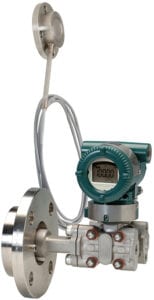
Yokogawa
Ambient temperature swings handled by this DP transmitter
For tanks located outdoors, ambient temperature conditions can interfere with level measurement due to the expansion and contraction of oil inside capillary tubes that are connected to diaphragm seals. The EJXC80A Diaphragm Seal System (photo) was designed with a unique compensating capillary specifically to address this issue. The compensating capillary is an additional capillary tube on the high-pressure side of the transmitter that balances the volume of fill fluid with the capillary on the low-pressure side. This allows both the high- and low-side fill fluids to be exposed to the same conditions and effectively eliminates errors caused by changes in ambient temperature. By reducing variability in tank measurements, chemical storage capacity can be increased and operators can better manage production targets. In addition, there is no need to perform manual checks to confirm tank levels and periodically re-zero the transmitter. — Yokogawa Corp. of America, Sugar Land, Tex.